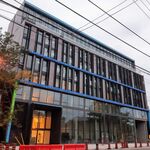The city should produce some renderings of these separated bike lanes. To make them functional to an acceptable standard as
this New York bike lane, one would have to eliminate all street parking on a standard Toronto four lane street. (One should note, however, that the random manhole covers in this New York example don't ensure the kind of smooth surface best for cycling.) Only by using the entire car lane could the width of the lane would ensure that passing could be done safely and efficiently while maintaining separation. It's the only functional solution for separated, unidirectional bike lanes.




